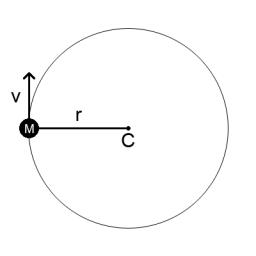Circular motion
The mass point regularly moves in a circle with radius r = $r m angular velocity ω = 4.3 rad/s. Calculate the period, frequency, and centripetal acceleration of this movement.
Final Answer:

Tips for related online calculators
Do you want to convert velocity (speed) units?
Do you want to convert time units like minutes to seconds?
Do you want to convert time units like minutes to seconds?
You need to know the following knowledge to solve this word math problem:
planimetricsUnits of physical quantitiesthemes, topicsGrade of the word problem
We encourage you to watch this tutorial video on this math problem: video1
Related math problems and questions:
- Acceleration of point
 The mass point moves evenly along a circle with a radius of 1.2 m at an angular velocity of 25 rad/s. Determine the frequency, period, and centripetal acceleration!
The mass point moves evenly along a circle with a radius of 1.2 m at an angular velocity of 25 rad/s. Determine the frequency, period, and centripetal acceleration! - Constant Angular Acceleration
 The particle began to move from rest along a circle with a constant angular acceleration. After five cycles (n = 5), its angular velocity reached the value ω = 12 rad/s. Calculate the magnitude of the angular acceleration ε of this motion and the time int
The particle began to move from rest along a circle with a constant angular acceleration. After five cycles (n = 5), its angular velocity reached the value ω = 12 rad/s. Calculate the magnitude of the angular acceleration ε of this motion and the time int - Rotational motion of a cylinder
 Calculate the kinetic energy of a cylindrical body of radius r= 0.08 meter and mass m= 1.5kg at time t= 5 s, if this body rotates around an axis passing through the center of the cylinder with a constant acceleration Ԑ= 5 rad/s², if at time t=.
Calculate the kinetic energy of a cylindrical body of radius r= 0.08 meter and mass m= 1.5kg at time t= 5 s, if this body rotates around an axis passing through the center of the cylinder with a constant acceleration Ԑ= 5 rad/s², if at time t=. - Overload
 Calculate how many g's (gravity accelerations) the glider pilot when turning the horizontal circles of radius 139 m flying at 126 km/h. Centripetal acceleration is proportional to the square of the speed and inversely proportional to the radius of rotatio
Calculate how many g's (gravity accelerations) the glider pilot when turning the horizontal circles of radius 139 m flying at 126 km/h. Centripetal acceleration is proportional to the square of the speed and inversely proportional to the radius of rotatio - Angular velocity
 Determine the difference in angular velocities of the clock hands. [rad/s] ω of clock hands =? ω minute hands =? ω second hands =?
Determine the difference in angular velocities of the clock hands. [rad/s] ω of clock hands =? ω minute hands =? ω second hands =? - Acceleration 83304
 The acceleration of a mass point during its rectilinear movement decreases uniformly from the initial value a0 = 10 m/s2 at time t0 = 0 to a zero value for a period of 20 s. What is the speed of the mass point at time t1 = 20 s, and what is the path of th
The acceleration of a mass point during its rectilinear movement decreases uniformly from the initial value a0 = 10 m/s2 at time t0 = 0 to a zero value for a period of 20 s. What is the speed of the mass point at time t1 = 20 s, and what is the path of th - Merry-go-round 82611
 Calculate the magnitude of the angular velocity of the seat of a merry-go-round moving in uniform motion in a circle with an orbital period of 0.2 minutes.
Calculate the magnitude of the angular velocity of the seat of a merry-go-round moving in uniform motion in a circle with an orbital period of 0.2 minutes.
